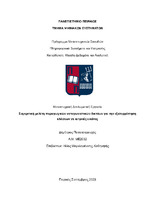Συγκριτική μελέτη παραγωγικών ανταγωνιστικών δικτύων για την εξισορρόπηση κλάσεων σε ιατρικές εικόνες

Προβολή/
Λέξεις κλειδιά
Τεχνητή νοημοσύνη ; Ανταγωνιστική μάθηση ; Βαθιά μάθηση ; Εμπλουτισμός δεδομένων ; Γεννητικά ανταγωνιστικά δίκτυα ; Παραγωγικά ανταγωνιστικά δίκτυα ; ΑλτσχάιμερΠερίληψη
Η ανάπτυξη της τεχνολογίας και ειδικότερα της μηχανικής μάθησης φαίνεται να εξελίσσεται με γοργούς ρυθμούς τα τελευταία χρόνια, με τεχνικές βαθιάς μάθησης και υπολογιστικής όρασης, να χρησιμοποιούνται για την επίλυση διαφόρων προβλημάτων σε ποικίλους τομείς. Η συλλογή δεδομένων αποτελεί σημαντική πρόκληση σε πολλούς κλάδους, καθώς η εξασφάλιση αξιόπιστων και επαρκών δεδομένων απαιτεί προσπάθεια και χρόνο από ειδικούς του κάθε κλάδου. Ειδικά στο επιστημονικό πεδίο της ιατρικής, η συλλογή δεδομένων υγειών ατόμων μπορεί να είναι σχετικά ευκολότερη σε σύγκριση με τη συλλογή δεδομένων από ασθενείς, ιδιαίτερα όταν πρόκειται για σπάνιες ασθένειες. Αυτό δημιουργεί ένα πρόβλημα ανισορροπίας στο σύνολο δεδομένων, κάτι το οποίο κάνει δύσκολη την αξιοποίηση των τεχνικών μηχανικής μάθησης . Για την αντιμετώπιση του προβλήματος της ανισορροπίας κλάσεων έχουν προταθεί διάφορες τεχνικές όπως ο εμπλουτισμός δεδομένων με τεχνητά δείγματα. Η παρούσα διπλωματική εργασία, προτείνει την αντιμετώπιση του προαναφερθέντος προβλήματος, με τη χρήση Παραγωγικών Ανταγωνιστικών Δικτύων (GAN). Τα GANs είναι μοντέλα μηχανικής μάθησης τα οποία παράγουν ρεαλιστικές τεχνητές εικόνες. Αποτελούνται από 2 νευρωνικά δίκτυα, τον Γεννήτορα (Generator) και τον Διευκρινιστή (Discriminator), με το πρώτο να προσπαθεί να παράξει τεχνητές εικόνες όμοιες με τις πραγματικές και το δεύτερο να επιδιώκει να διαχωρίσει τις τεχνητές από τις πραγματικές εικόνες. Η εκπαίδευσή τους έχει ως στόχο τον ανταγωνισμό των δύο δικτύων με τη συνεχή βελτίωσή τους, μέχρι το σημείο όπου οι τεχνητές εικόνες να φαίνονται όμοιες με τις πραγματικές.
Η μελέτη εστιάζει στο σύνολο δεδομένων OASIS-3, το οποίο περιλαμβάνει εικόνες Μαγνητικής Απεικόνισης (MRI) εγκεφάλων από υγιή άτομα και ασθενείς με Αλτσχάιμερ. Η πειραματική διαδικασία αποτελείται αρχικά από τη λήψη και την επεξεργασία των δεδομένων. Έπειτα πραγματοποιείται η δοκιμή διαφόρων αρχιτεκτονικών GAN για τη δημιουργία τεχνητών εικόνων ασθενών, με στόχο την επιλογή των καταλληλότερων αρχιτεκτονικών. Στη συνέχεια δημιουργούνται τεχνητές εικόνες από τις επιλεγμένες αρχιτεκτονικές και προστίθενται στο αρχικό σύνολο δεδομένων, δοκιμάζοντας 5 διαφορετικές περιπτώσεις που περιλαμβάνουν διαφορετικά ποσοστά εισαγωγής τεχνητών εικόνων. Τέλος πραγματοποιείται η εκπαίδευση ενός ταξινομητή ResNet18 με τη χρήση των διαφορετικών εμπλουτισμένων συνόλων και συγκρίνονται τα αποτελέσματα από το αρχικό σύνολο δεδομένων.
Όπως διαπιστώθηκε μετά από εκτενή μελέτη και ανάλυση των αποτελεσμάτων της έρευνας, η προσθήκη τεχνητών εικόνων φαίνεται να επηρεάζει σε μικρό βαθμό την απόδοση του ταξινομητή, παρατηρώντας ελάχιστη βελτίωση των μετρικών με την προσθήκη μικρού ποσοστού τεχνητών εικόνων (10%-20%) στην κλάση των ασθενών AD. Σε μεγαλύτερα ποσοστά τεχνητών εικόνων, παρατηρείται η αδυναμία του ταξινομητή να εντοπίσει τις περιπτώσεις της μειονοτικής κλάσης, ενώ παράλληλα οι μετρικές εμφανίζουν σταδιακή επιδείνωση.


